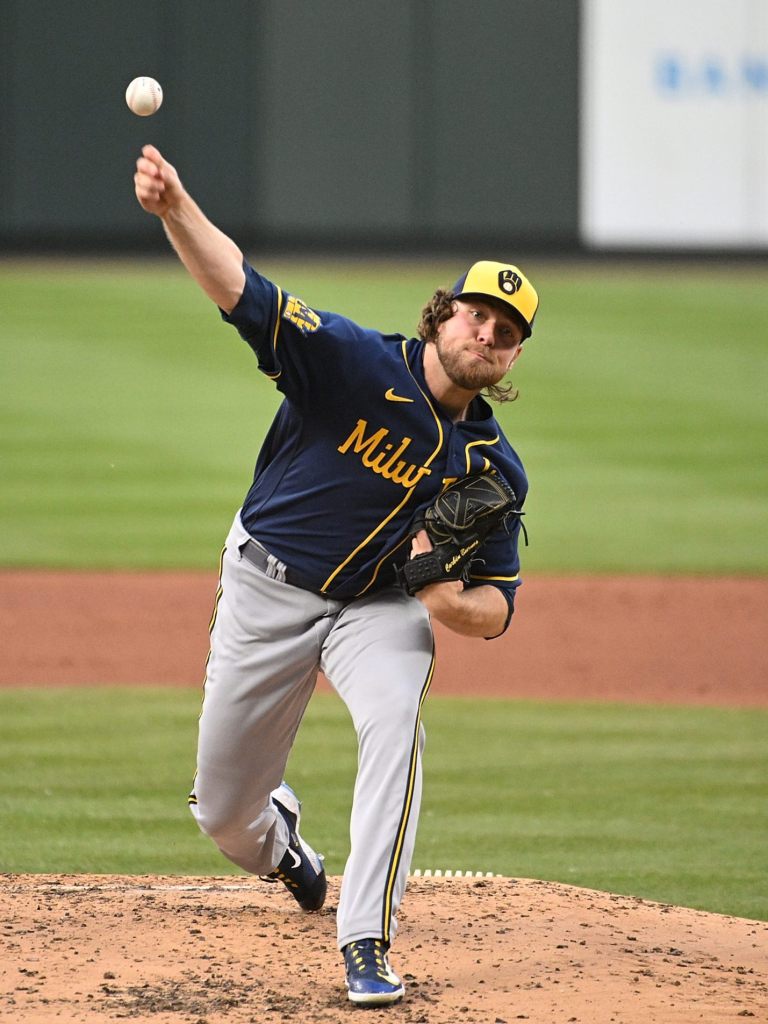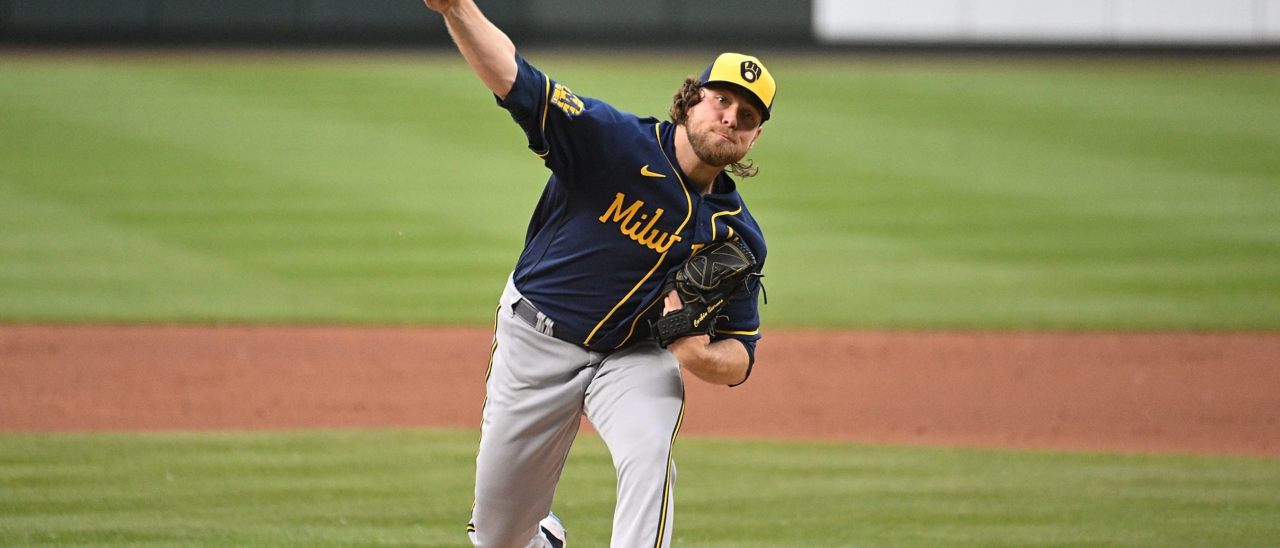Understanding Pitch Classification In The Pitch-Tracking Era


Image credit: Corbin Burnes (Photo by Joe Puetz/Getty Images)
Identifying pitches without the help of TrackMan, Hawk-Eye or other ball-tracking devices is as much an art as it is science. Baseball America can help. In this piece we will define various pitch types and their individual traits via grips and movement styles.
Ambiguity exists within pitch movement profiles. For example, one pitcher’s slider could move similarly to another pitcher’s curveball. This is especially true of sliders, a pitch that has a range of movement profiles that covers the spectrum of curveballs to cutters and helps bridge the gap between multiple pitch types.
This is why ball-tracking devices are helpful. They clarify certain aspects of pitch movement that the human eye can’t fully process. It allows us to be more precise about the quality of a particular pitch and how it might translate to higher levels when evaluating amateur and minor league prospects.
Let’s walk through the different pitch types and subclassifications within each to gain a better understanding.
Four-Seam Fastball
This is the classic fastball shape. It’s thrown with a grip that places the index and middle fingers across the seams of the baseball horizontally. It’s defined by more vertical than horizontal movement, meaning it rides more than it runs.
We measure vertical movement by using induced vertical break. This measurement removes gravity from the equation and looks at how much a pitch moves up or down from a point of zero. Four-seam fastballs all have a positive IVB number, an above-average induced vertical break number is 18 inches or more. Pitchers capable of reaching 20 inches of IVB are considered to have elite vertical movement on their fastball.
A variety of shapes exist within the four-seam fastball archetype. All four-seamers move horizontally to the pitcher’s arm side. That figure, combined with the pitch’s IVB, defines the pitch’s shape. Anything with nine or more inches of horizontal break combined with 17 or more inches of IVB is considered to have heavy bore.
Meanwhile, four-seam fastballs with horizontal movement readings closer to zero are considered to have cut. There is a point where fastballs with only 1-3 inches of horizontal movement are considered cut fastballs, though they’re unlikely to be categorized as such.
Four-seam fastballs utilize something called Magnus force to create movement. Simply put, this is spin that contributes in an efficient way toward the movement of the pitch. When considering spin efficiency, it’s important to take note of how much a pitch’s spin contributes to movement. Every pitch has a spin axis upon which it moves and an efficient pitch—close to 100% spin efficiency—will rely on Magnus force to create its shape.
Two-Seam Fastballs And Sinkers
These pitch types fall under the fastball archetype but are defined by having more horizontal armside movement or run than a four-seam fastball. There’s some ambiguity about the differences between a true sinker and two-seam fastball. It’s a thin line of differences.
The sinker typically has less than 10 inches of vertical movement and is more likely to be in the range of 6-9 inches of induced vertical break, meaning it sinks and runs more than it rides.
The two-seam grip is executed by placing the middle and index fingers along the seams of the baseball vertically. There are variations of this grip, but it’s always achieved by the pitcher placing these two fingers along the vertical seams of the ball. These pitches tend to have more than 12 inches of horizontal run, and can have up to 19-20 inches of horizontal movement.
The term seam-shifted wake, or the deviation of a pitch’s movement off its spin axis creates this effect. It’s a phenomenon that is created when the pitcher throws a pitch that seems to deviate from its intended spin axis. The late movement often visible on a two-seam fastball or a changeup, where the pitch seems to downshift and change direction, is a product of seam-shifted wake. It’s a byproduct of the smooth part of the ball interacting with the air around it and creating movement that’s not defined by the Magnus force that contributes to a four-seam fastball’s movement.
Changeups
While there are a variety of changeup shapes, they tend to fall into two primary categories: a traditional changeup and a splitter. Some pitchers throw screwball-changeups as well, but the term screwball is hardly used in the modern game.
Screwball-changeups, like the pitch thrown by Brewers closer Devin Williams tend to have more spin than a typical changeup. One of the defining characteristics of most changeups is a lack of spin, typically under 2,000 rpm.
The most common grip on the changeup is the circle-changeup, where the index and thumb create a “C” shape on the inside part of the ball. The Vulcan grip has become more popular in recent years. That grip features the ring and middle fingers creating a “V” shape along the vertical seams of the ball, with a “C” shape created on the side of the ball, similar to the circle grip. There’s also a star grip, where all five fingers are spread a near equal distance around the ball.
Changeups tend to try to mirror fastball shape out of the hand while killing lift off of the pitch. The goal of all changeup variations is to create a pitch that plays off of the fastball but dives and runs more than the fastball.
Cutters
The cutter classification is where things get somewhat murky. That’s because a healthy dose of cutters fall into both the fastball and slider classifications. Different pitchers call their cutter a fastball or a slider depending upon the velocity and amount of ride or induced vertical break on the pitch.
For example, Brewers ace Corbin Burnes’ primary pitch is a cut fastball. He throws the pitch about 55% of the time and averages 95 mph on it with more than 12 inches of induced vertical break. Yu Darvish also throws a cutter, but it sits in the mid 80s with only an inch or two of induced vertical break. Each pitch is a cutter, but Burnes’ falls more into the cut-fastball classification, while Darvish’s is classified as a breaking ball-style cutter.
However, each falls into the classification of cutter and shares a similar trait of having less horizontal movement than a fastball or slider while cutting only a few inches. A more standard cutter, like what Hunter Brown of the Astros calls his slider, tends to have a few inches of ride, say 2-7 inches, with 1-3 inches of horizontal break.
The spin axis on a cutter tends to be more vertical, similar to a fastball, with the middle and index fingers pushing against the seams of the ball in a vertical fashion. The seam orientation can vary. For example, Mariano Rivera’s famed cutter had horizontal seam orientation. Other pitchers used a more vertical seam orientation similar to a two-seam fastball.
The ambiguity of this pitch makes it a bridge pitch between fastballs and breaking balls, and we’ve seen more pitchers use it as an in-between option to keep hitters off their fastball or breaking ball. The ultimate goal with the pitch is to “cut” the pitch in half with finger pressure, which also gives the pitch type its name.
Sliders
No pitch casts a wider net in terms of classification of movement profile than the slider. There are a few main variations: a gyro slider or a bullet-spin slider that has the classic slider identification marker of the spinning red dot in the middle. Lately, the sweeper slider has been broken out separately into its own pitch classification. There’s also the cut-slider or “slutter”—see Hunter Brown’s slider or Yu Darvish’s cutter in the “cutters” section. Finally, there’s the slurve, which often falls into the curveball range depending upon the velocity on the pitch.
A general rule of thumb is if the pitch sits below 79-80 mph, then it’s likely classified as a curveball. By contrast, if a breaking pitch’s average velocity is above 80 mph, it’s typically classified as a slider.
The gyro slider has long been the most common of these pitches. Gyro sliders tend to be thrown harder, mostly in the range of 83 mph or faster, and some can sit in the upper 80s. It’s a low spin-efficiency pitch without much vertical or horizontal break that moves in a similar fashion to a football.
The benefit of the gyro slider is its ability to play off the fastball and be thrown harder than other breaking balls. Many gyro sliders get late break and can see late dive, though it’s not a dynamic late drop like a curveball or slurve.
A slurve is a hybrid of a slider and a curveball. A slurve is a two-plane breaking ball with a near equal amount of vertical drop and horizontal sweep. Good slurves typically average more than -8 inches of induced vertical break and more than 7 inches of horizontal sweep. These tend to be 11-to-5 breaking balls or 1-to-7 breaking balls and often are categorized as curveballs.
Sweepers
This is a subclass of sliders and curveballs that’s grown in popularity over the years. It historically has been categorized as a curveball, but as pitchers have begun to throw sweepers harder it’s fallen more into the slider category. At the end of the day, pitches are defined by what the pitcher categorizes the pitch as—slider or curveball—and this is often the case with sweepers.
Sweepers are defined by having a great deal of horizontal break and a minimal amount of vertical movement. There are sweepers that ride some, anywhere from 2-7 inches of induced vertical break—but it’s rare. There are some sweepers that drop, but anything more than 2-4 inches of negative IVB tends to border on the slurve categorization.
Pitchers achieve this sweep in different ways. Many sweepers rely on more true spin or spin efficiency to create sweep, while others, such as the Yankees-popularized “whirly,” use a seam orientation that creates additional, non-Magnus movement to create sweep.
For example, Andrew Heaney doesn’t generate a large amount of horizontal movement from a pure ball-tracking movement perspective. But due to his release, which creates a unique horizontal approach angle, the pitch looks to move more glove-side than it should. It’s a good example of how pitchers can create a unique movement from their release point in addition to spin.
Curveballs
These are defined in more standard terms in modern times. Most curveballs tend to be the classic 12-to-6 vertical dropping breaking ball or a slower sweeper or slurve in the mid 70s. Curveballs have fallen out of vogue to an extent, but in reality what many would have classified as a curveball as recently as five years ago now are classified as sliders or sweepers.
Key Terms
Ride
The common term for the type of movement captured by ball-tracking devices via a measurement known as induced vertical break or IVB. It can also be observed as movement created by backspin that makes the fastball appear to carry or stay on a particular plane. Good ride on a four-seam fastball is 18 inches of IVB or more.
Run
Defined as armside horizontal break, run is a defining characteristic of all fastball types—outside of a cut fastball—as well as changeups and splitters. You’ll also commonly hear the term “tail” used to define run.
Sweep
This is glove-side horizontal break, meaning it’s the mirror opposite of run. This is a defining characteristic of all types of breaking pitches, whether it be a slider or curveball.
Cut
This pertains to horizontal, glove-side movement that is more slight than sweep. This term is properly defined by cutters and cut fastballs. A pitcher can cut a four-seam fastball, but it’s likely to still have more run than sweep. It simply means the fastball’s horizontal run is limited by spin that doesn’t contribute to true spin or a fastball with lower spin efficiency.
Spin efficiency
The amount of spin that contributes to true movement of a pitch. By identifying spin efficiency or spin-induced movement—also referred to as true spin or active spin—we can identify if a pitch moves a certain way due to magnus force or gyroscopic spin.
Magnus force
An observable phenomenon commonly associated with a spinning object moving through a fluid. The path of the spinning object is deflected in a manner not present when the object is not spinning.
Gyroscopic spin
The tendency of a rotating object to maintain the orientation of its rotation. A rotating object possesses angular momentum and this momentum must be conserved. The object will resist any change in its axis of rotation, because a change in orientation will result in a change in angular momentum. A football is an example of an object that utilizes gyro spin or bullet spin.
Bore
A common term used to describe four-seam fastball movement that both rides and runs. This causes the pitch to move both vertically and horizontally to the pitcher’s arm side. Gerrit Cole’s fastball is an excellent example of a pitch with heavy bore.

Comments are closed.